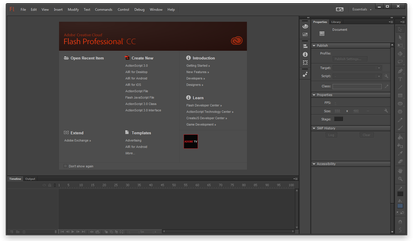Flash
Adobe Flash can find its origins back in some original software named FutureSplash Animator released in 1995. This project combined animated media with vector graphics to create an alternative for Java developers on the web.
In 1996 this software was purchased by Macromedia. The words “Future” and “Splash” were combined to create the more familiar “Flash”. The whole software suite was devoted towards creating animations and dynamic content which could be published on the Internet. There wasn’t a whole lot of exciting possibilities until the ActionScript language was paired with the software.
The released of Flash 4 in 1999 included an overhaul of the scripting language. Developers could target graphics on the screen and call functions to animate them throughout different frames. It’s arguable that ActionScript was one of the defining programming languages which eventually pushed Flash technology further into the mainstream. By now Flash Player was already somewhat popular and growing very quickly.
By early 2002-2003 Macromedia updated the Flash/ActionScript pair with the largest innovative push forward. ActionScript 2.0 paired with the software suite Flash MX 2004 was a powerhouse for generating dynamic web content. AS 2.0 is a fully-fledged Object-Oriented programming language similar to Java or PHP or C++. You could build entire websites running on Flash – let alone custom UI panels such as video players or mp3 playlists.
(Source: Jake Rocheleau, http://speckyboy.com/2012/09/05/a-history-lesson-on-the-rise-and-fall-of...)
Works Developed in this Platform:
- 1 of 26
- next ›
Critical Writing Developed in this Platform:
Flash Player Version HistoryFlash Player VersionRelease Date Notable New Features Flash 21997Buttons, libraries, stereo audio, improved bitmap integration, tweening.
Note: This was the first player released under the Macromedia brand.Flash 31998Alpha transparency, MP3 support.Flash 4May 1999Streaming MP3 support, motion tweening.
Note: This was the first player included by default with MS Internet Explorer (v5).Flash 5August 2000ActionScript.Flash 6March 2002Video support (Sorenson Sparc codec), application components, shared libraries, accessibility.Flash 7September 2003Charts & graphs, text effects, 3rd-party extensions, high-quality PDF & Adobe Illustrator import. ActionScript 2.0.Flash 8August 2005Filter effects, blending modes, GIF & PNG support, bitmap caching, FlashType type rendering, mobile device emulator, and a significant new video codec (On2 VP6).
Note: In December 2005 Macromedia (and the Flash platform) was acquired by Adobe Systems.Flash 9June 2006ActionScript Virtual Machine AVM2, ActionScript 3.
Note: This was the first version of the player to be released before the equivalent authoring program. This means version 9 was the first player to be widely installed before much authoring activity.Flash 9 Update 1November 2006(v9.0.28.0, codenamed "Marvin")
Support for fullscreen mode.Flash 9 Update 3December 2007(v9.0.115.0, codenamed "Moviestar")
Support for H.264 video and AAC audio.Flash 10October 2008(v10.0.12.36, codenamed "Astro")
3D object transformations, advanced text features, Speex audio codec, RTMFP support (Real Time Media Flow Protocal), larger bitmap support, enhanced clipboard access, enhanced anti-aliasing engine.Flash 10.1June 2010(v10.1.53.64)
Global error handling, multi-touch, HTTP streaming, hardware H.264 decoding.Flash 10.2(Previewed September 2010)Support for 64-bit browsers.
(Source: http://www.mediacollege.com/adobe/flash/player/version/)
Version 17.0.0.134 (2015)


